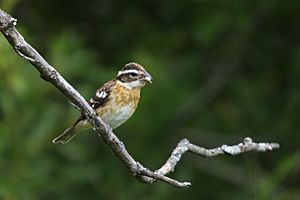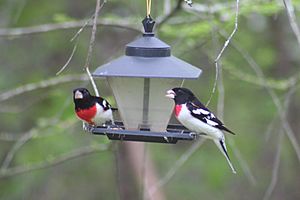Rose-breasted grosbeak facts for kids
Quick facts for kids Rose-breasted grosbeak |
|
|---|---|
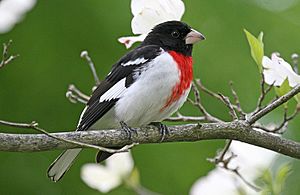 |
|
| Adult male | |
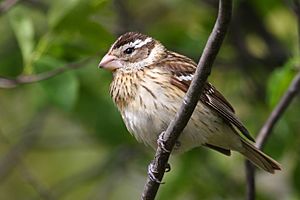 |
|
| Adult female | |
| Conservation status | |
| Scientific classification | |
| Genus: |
Pheucticus
|
| Species: |
ludovicianus
|
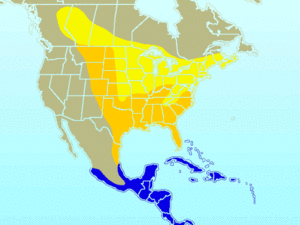 |
|
| Range in northern America: Breeding range Migration only range Wintering range | |
| Synonyms | |
|
|
The rose-breasted grosbeak (Pheucticus ludovicianus) is a large bird that eats seeds. It belongs to the cardinal family. This bird mostly finds its food among leaves in trees. Male and female grosbeaks look very different from each other.
Males have black heads, wings, backs, and tails. They have a bright rose-colored patch on their white chest. These birds live in cooler, open forests with trees that lose their leaves across much of eastern North America. In winter, they fly south to warmer, tropical parts of America. Rose-breasted grosbeaks can live up to 7.3 years in the wild. In zoos or special care, they can live for up to 24 years.
Contents
What is the Rose-breasted Grosbeak?
The rose-breasted grosbeak is a type of grosbeak. It is known for its strong, thick beak, which helps it crack open seeds. The scientific name for this bird is Pheucticus ludovicianus.
How did the Rose-breasted Grosbeak get its name?
In 1760, a French zoologist named Mathurin Jacques Brisson wrote about the rose-breasted grosbeak. He saw a bird from Louisiana. He called it Le gros-bec de la Louisiane in French.
Later, in 1766, the famous Swedish naturalist Carl Linnaeus gave the bird its first scientific name, Loxia ludoviciana. This was part of his updated book, Systema Naturae. Today, the bird is in the genus Pheucticus. This name comes from an Ancient Greek word meaning "shy." The second part of its name, ludovicianus, means "from Louisiana."
What does a Rose-breasted Grosbeak look like?
Adult rose-breasted grosbeaks are about 18 to 22 centimeters (7 to 8.7 inches) long. Their wings spread about 29 to 33 centimeters (11 to 13 inches) wide. They weigh between 35 and 65 grams (1.2 to 2.3 ounces). Males and females are similar in size. Their beaks are dark, and their eyes and feet are dark too.
Male Rose-breasted Grosbeaks
When it's time to breed, adult male grosbeaks are easy to spot. They have a black head, wings, back, and tail. Their chest has a bright rose-red patch. Their wings have two white patches and rose-red feathers underneath. Their belly and rump are white.
In winter, the males look a bit different. Their undersides are mostly white. The feathers on their upper body have brown edges, making them look a bit scaly. Even in winter, the male rose-breasted grosbeak is unique and easy to recognize.
Female Rose-breasted Grosbeaks
Adult female grosbeaks have dark grey-brown feathers on their upper parts. Their wings and tail are darker. They have a white stripe above their eye and a buff-colored stripe on top of their head. Their undersides are white with black streaks. The feathers under their wings are yellowish. They also have two white patches on their upper wings, like the males.
Young birds look similar to females. They have pinkish wing linings and less clear streaks. Young males might have a pinkish-buff color on their throat and chest.
How to tell females apart
Female rose-breasted grosbeaks can sometimes be confused with the black-headed grosbeak. This happens where their living areas overlap in the central United States and Canada. The female rose-breasted grosbeak has slightly darker brown marks on her underside. Her head and wings have paler, yellowish streaks. Her beak is pinkish, not two-colored.
Another bird that looks a bit like the female is the purple finch. However, the purple finch is much smaller. It also has a less strong beak and a tail that is notched.
What does the Rose-breasted Grosbeak sound like?
The song of the rose-breasted grosbeak is soft and sweet. It sounds like a nicer version of the American robin's song. Males start singing early, sometimes even before they leave their winter homes. Their call is a sharp "pink" or "pick" sound. It can remind you of a woodpecker's call.
Where do Rose-breasted Grosbeaks live?
Rose-breasted grosbeaks breed in open deciduous forests. These forests are found across most of Canada and the northeastern United States. When winter comes, these birds fly south. They travel through the United States, east of the Rocky Mountains. They spend winter from central-southern Mexico through Central America and the Caribbean down to Peru and Venezuela.
In winter, they prefer more open woodlands. They also like places with scattered trees, such as forest edges, parks, gardens, and plantations. They can be found from sea level up to about 1,500 meters (5,000 feet) high in places like Costa Rica.
How do Rose-breasted Grosbeaks migrate?
Some birds start leaving their breeding areas as early as August. Others do not return until mid-to-late May. Generally, they fly south in late September or October. They come back north in late April or early May.
It seems they stay in their breeding areas longer now than they did in the early 1900s. Back then, people saw more migrating birds in May and August. The rose-breasted grosbeak is rarely seen in western Europe. During breeding season, they protect their territory. In winter, they travel in small groups of a few birds. Sometimes, they form larger flocks of a dozen or more.
Life Cycle and Behavior
Reproduction and Nesting
Male rose-breasted grosbeaks are special. They are one of the few songbirds that can produce sperm while still far from their breeding grounds. Males usually arrive at the breeding areas a few days to a week before the females. They then find a mate there.
Nest building starts in early May in places like Tennessee. It can be as late as early June further north in Saskatchewan. Eggs are laid from mid-May to mid-July. This has been seen in Quebec. These birds usually have only one group of chicks each summer. However, a second group is sometimes seen in Canada and has been confirmed in birds kept in semi-captivity.
Both the male and female help choose and build the nest. Nests are built on tree branches, over vines, or any raised woody plant. Nests have been found from 0.8 to 16.7 meters (2.6 to 55 feet) off the ground. The average height is about 6 meters (20 feet). They are almost always near open areas in the woods.
The nests are like those of many other small birds. They are made from leaves, twigs, small roots, or hair. A female lays 1 to 5 eggs, but usually 3 or 4. The eggs are pale blue to green with purplish to brownish-red spots. The male helps with about a third of the incubation, and the female does the rest. Incubation lasts from 11 to 14 days.
When they hatch, nestlings weigh about 5 grams (0.18 ounces). After 3 to 6 days, they gain at least 3 grams (0.11 ounces) each day. Young grosbeaks usually leave the nest when they are 9 to 13 days old. They become independent from their parents after about 3 weeks.
How long do Rose-breasted Grosbeaks live?
The longest a wild rose-breasted grosbeak has lived is 12 years and 11 months. Birds kept in captivity have lived up to 24 years. This makes them quite long-lived for a small bird, especially when they don't face dangers in the wild.
These birds are often targeted by brown-headed cowbirds. Cowbirds lay their eggs in other birds' nests. However, rose-breasted grosbeaks seem to know cowbird eggs. They have been seen chasing cowbirds away from their nests. Studies show that fewer than 7% of grosbeak nests have cowbird eggs.
Most deaths in wild grosbeaks are due to hitting objects like buildings and cars. Some are also caught by cats. The main reason nests fail is because of predators. Animals that eat eggs and nestlings include blue jays, common grackles, raccoons, and gray and red squirrels. Adult grosbeaks can be eaten by hawks like Cooper's and sharp-shinned hawks. Owls like the Eastern screech owl and short-eared owl also hunt them.
What do Rose-breasted Grosbeaks eat?
The rose-breasted grosbeak looks for food in shrubs or trees. They eat insects, seeds, and berries. They also catch insects while flying. Sometimes, they even eat nectar. They usually stay in the treetops and rarely come down to the ground.
In their winter homes, they can be attracted to parks and gardens by fruits. They also eat blackberries, mulberries, and seeds from plants like smartweed and milkweed. They enjoy sunflower seeds, garden peas, oats, wheat, tree blossoms, and tree buds.
A study of grosbeaks from the north-central United States and southern Canada showed what they eat. About 52% of their diet was invertebrates, mostly beetles. Wild fruit made up 19.3%. Weed seeds were 15.7%. Cultivated fruits and plants, like peas, corn, oats, and wheat, were 6.5%. The remaining 6.5% was other plant material, such as tree buds and flowers.
Is the Rose-breasted Grosbeak in danger?
The rose-breasted grosbeak is not considered a threatened species by the IUCN. This means it is not rare. Even though it needs mature forests to breed, its numbers are stable.
In some areas, like the Great Plains, forests have grown into grasslands. This happened because fires, which used to keep grasslands open, were stopped. This has led to some mixing with the black-headed grosbeak. The rose-breasted grosbeak has also spread to new areas, like northern Ohio, where it was rare before but is now common.
Images for kids
See also
 In Spanish: Picogrueso pechirrosa para niños
In Spanish: Picogrueso pechirrosa para niños



